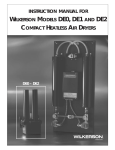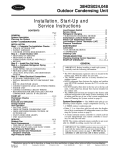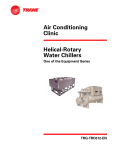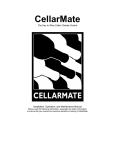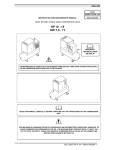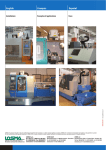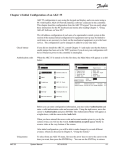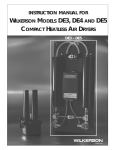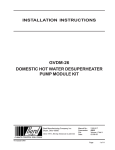Download AT&T D-320 User's Manual
Transcript
107 W. Main Street Worthington, PA 16262 Phone: 724.297.3416 Fax: 724.297.5189 http://www.airtak.com OPERATING INSTRUCTIONS Refrigerated Air Dryers Models D-320 through D-10,000 4-2002 Contents A. INTRODUCTION B. RECEIVING C. LOCATION D. FOUNDATION E. PIPING F. ELECTRICAL G. COMPRESSED AIR CIRCUIT 1. Air to Air Heat Exchanger 2. Air to Refrigerant Heat Exchanger (Evaporator) 3. Drain Traps H. REFRIGERANT CIRCUIT 1. Refrigerant Compressor 2. Air-Cooled Condenser and Condenser Fan Cycling Control (Low Ambient) 3. Air to Refrigerant Heat Exchanger (Evaporator) 4. Expansion Valves 5. Hot Gas Bypass Valve (D-320 and Larger) 6. Low Pressure Switch 7. High Pressure Switch 8. Crankcase Heater (D-320-A thru D-2000-A and D-400-W thru D-1000-W) 9. Automatic Water Regulating Valve 10. Oil Sightglass 11. Refrigerant Liquid Line Filter Dryer 12. Water Pressure Switch 13. Desuperheating Valve (D-1600 and Larger) 14. High Temperature Control 15. Start Timer I. START-UP J. DESIGN CONDITIONS K. SHUTDOWN L. WATER-COOLED MODELS: Cooling Water Requirements M. MAINTENANCE 1. Drain Valves 2. Refrigeration Condenser 3. Condenser Fans N. REMOTE CONDENSER INSTALLATION (OPTIONAL) TROUBLESHOOTING GUIDE WARRANTY PROCEDURES OTHER AIR/TAK PRODUCTS 2 A. INTRODUCTION AIR/TAK Refrigerated Compressed Air Dryers are of the high-efficiency type, designed to effectively remove moisture from compressed air by means of a refrigeration process. The compressed air pressure dewpoint is reduced to 38°F and then reheated to prevent in-plant air lines from sweating. The 38°F dewpoint can be maintained under varying conditions from zero load to 100% of the design conditions. AIR/TAK dryers are completely automatic in all respects. As with all AIR/TAK products, only a minimum of maintenance is required. It is our recommendation that this manual be followed for any maintenance that might be required. Any, and all service should be performed by a qualified refrigeration engineer who is trained in the service of refrigerated air dryers. B. RECEIVING Upon receiving your air dryer: 1. Inspect the shipping carton for any apparent damage. 2. After removing the crate, inspect the unit for any hidden damage. 3. Report any damage immediately to the carrier and notify your supplier. C. LOCATION Air cooled dryers must have cool ambient air made available to prevent a heat build-up in the area where the dryer is installed. An exhaust system is recommended to avoid recirculation of hot condenser air. Ambient temperature at the selected location should not exceed 100°F (38°C), 60 HZ; or 77°F (25°C), 50 HZ; and should not be lower than 50°F (10°C). High ambient temperature can affect the efficiency of the dryer. Every 10°F increase in ambient temperature above 100°F (38°C) will result in a 6% decrease in air cooled dryer performance, resulting in higher dewpoints and increased operating costs. To assure an unrestricted flow of cool air through the refrigeration condenser, a minimum distance from the cabinet to the nearest wall of 24 inches must be maintained. All outside installations must have weather protection. Minimum protection should include a shed roof. Air-cooled units must be protected against the wind. Ambient temperatures should not exceed 100°F (38°C) and should not be lower than 50°F (10°C) where a standard unit is to be located. If ambient temperatures below 50°F (10°C) are anticipated, the dryer should be equipped with an optional ultra-low ambient package. D. FOUNDATION All dryers are completely free-standing units. Any reasonably level floor that has sufficient strength will serve as a foundation. E. PIPING When piping the main air lines to the dryer, the use of flexible connections or union joints is recommended to avoid piping stress and vibration when used with reciprocating compressors. Bypass piping and valves are recommended. The bypass will permit isolation of the dryer for servicing and will eliminate the need to shut down the complete compressed air system. The bypass must be provided and installed by the customer. 3 In keeping with good compressed air piping design, the air dryer should be installed on the downstream side of the air receiver and aftercooler. An AIR/TAK prefilter(s) for oil and dirt removal installed at the inlet of the dryer is recommended. Contamination can be present in a compressed air system and can reduce the ability of the dryer heat exchangers to achieve the proper heat transfer. AIR/TAK recommends the use of afterfilter(s) to remove final trace contaminates. All water cooled dryers are factory piped for cooling tower water, unless ordered otherwise. A dryer that is piped for city water cannot be used on cooling tower water without necessary piping changes because of: the higher water temperature, lower water pressure and the increased water flow needed. All water cooled dryers are supplied with a factory mounted automatic water regulating valve which is designed to maintain the proper working refrigerant head pressure under all dryer load conditions. No adjustment will be necessary. (Full water pressure and flow should be supplied to the water line inlet. Refer to Section L for water cooled water requirements.) All dryers are supplied with automatic drain valves. On models D-320 to D-2000, an isolation valve/strainer and solenoid drain valve is provided for the outlet of the air to-refrigerant heat exchanger. Models D-2500 to D-7500 dryers are supplied with two drain outlets with zero air loss valve provided for each outlet. Models D-8000 and larger are supplied with four drain outlets and two zero air loss drain valves. Solenoid drain valves with isolation valve/strainer and zero air loss drain valves are to be installed at destination. F. ELECTRICAL The dryer is completely wired at the factory. A terminal box at the rear of the dryer, or a control box on the side of the dryer is provided for the main power connection. Power connections can be made through any knock-out on the terminal box or through the side or top of the control box. The dryer dataplate must be checked to verify voltage, phase and cycle. Connect the power leads to the terminal block which is conveniently located within the box. Always be sure adequate power is available to maintain efficient operation of your dryer. A properly sized fused main disconnect switch (supplied by the installer) must be located near the dryer. Check the wiring diagram supplied with the dryer for the recommended fuse size. The use of fusetron time-delay fuses will permit smaller fuse sizes and, in some instances, a smaller fused disconnect switch may be used. The dryer wiring must be independent of the air compressor so as not to cycle along with the air compressor. Fan rotation must be checked to assure proper air flow. Air must be drawn through the finned condenser and exit through the fan guard. To change fan rotation, switch any two hot power leads on the terminal block located in the box. Dryers with scroll compressor(s) need to be checked for proper rotation by making sure the discharge pressure is greater than the suction pressure. To change rotation, switch inlet power leads L1 and L3. If you have any question or problems, please consult factory. Dryers with pre-wired solenoid drain valves need to have the DIN connector attached to the drain valve after the drain is installed on the dryer. On units supplied with crankcase heaters, the crankcase heaters are pre-wired at the factory to be energized when power is supplied to the dryer. It is important that the crankcase heaters be energized at least 24 hours before initial start-up or after prolonged shut-down. (See Start-Up). 4 G. COMPRESSED AIR CIRCUIT 1. Air-to-Air Heat Exchanger: This unique high-efficiency heat exchanger is of a finned shell and tube design. The tubes are of high quality copper and are enhanced by outer fins of corrugated aluminum. The air is first directed into the shell of the heat exchanger and is baffled back and forth across the finned tubes giving off its heat to the cool, dry air as it passes through the tube side of the heat exchanger. 2. Air-to-Refrigerant Heat Exchanger (Evaporator): This heat exchanger is also of the finned shell and tube design. The evaporator is engineered with maximum efficiency in mind. It also incorporates the high quality copper tubes with corrugated fins and is baffled in the same manner as the air-to-air heat exchanger. The heat is transferred from the compressed air to the refrigerant within the tubes and is then dissipated to atmosphere through the condenser coil in the refrigeration system. Designed into the lower half of the heat exchanger is an ultra-low velocity separator section which extracts and discharges the moisture as it is condensed. This separation process traps and keeps the moisture from reentering the compressed air flow. 3. Drain Valves: TYPE: Solenoid Drain Valve (D-320 to D-2000). Zero Air Loss Drain Valve(s) (D-2500 to D-10000). H. REFRIGERANT CIRCUIT 1. Refrigerant Compressor: The refrigerant compressor used is an industrial type, of full hermetic, semi-hermetic or scroll design. These compressors can be either single phase or three phase, depending on the application. The compressors used are designed for high temperature applications which allow an evaporation temperature range of 20°F (-7°C) to 50°F (10°C). Each compressor motor is fully protected by either an internal or external overload which is of the automatic reset type. All compressors used are suction gas-cooled and have a wide working range. The connected electrical load can vary with the compressor load, ambient temperature or cooling water temperature. 2. Air-Cooled Condenser and Condenser Fan Cycling Control (Low Ambient): All air cooled condensers used in the AIR/TAK dryers are industrial plate fin type coils, designed for maximum ambient conditions. Each condenser has a sub-cooling system which permits the condensed refrigerant to be sub-cooled below the normal condensing temperature to within 10°F of the ambient temperature. The condensers are forced convection type and the fan motor(s) is controlled by a pressure switch(s) (lowambient control). This pressure switch is activated by the condenser head pressure. This pressure will vary with the ambient temperature and evaporator load. As the pressure increases to a factory set cut-in pressure, the fan switch closes and the fan motor starts. The fan removes the heat within the condenser and lowers head pressure to the factory set cut-out point. With the fan switch controlling the upper and lower pressure limits, the dryer can operate through a wide range of ambient and load conditions. When the ambient is high and the dryer is operating at full load, the condenser pressure and temperature will stabilize and the fan(s) will run continuously. 3. The Evaporator Air-to-Refrigerant Heat Exchanger: The evaporator is constructed of high quality copper tubing that utilizes an extended surface of corrugated aluminum fins. The tubes are set in a staggered pattern for maximum heat transfer. Each refrigerant circuit is fed by a venturi type refrigerant distributor which insures that cold liquid refrigerant is efficiently distributed to the bottom of each circuit. 5 The circuiting within the evaporator is serpentined in such a manner as to guarantee a completely flooded evaporator. Each evaporator is designed to insure adequate refrigerant velocity to eliminate the problem of oil return to the crankcase. 4. Expansion Valves: The thermostatic expansion valve (TXV) is used on Model D-320-A, and larger. This expansion valve is controlled primarily by temperature and requires a hot gas bypass valve to maintain pressure. The temperature that is sensed by the (TXV) thermal bulb is the superheat temperature of the refrigerant at the outlet of the evaporator. Superheat temperature is the temperature increase of the refrigerant above its saturation temperature corresponding to the existing evaporator pressures. 5. Hot Gas Bypass Valve: The hot gas bypass valve or capacity regulator permits medium to larger type refrigerated dryers to operate through the range from zero load to 100% load while maintaining evaporator and suction line pressure and temperature. 6. Low Pressure Switch: The low pressure switch is a safety device that protects the refrigeration compressor from running with low suction pressure that could result from a loss of refrigerant charge. 7. High Pressure Switch: The high pressure switch is a safety device that limits the discharge pressure from the refrigerant compressor. If the discharge pressure exceeds the factory set point, the high pressure switch opens the electrical circuit to the compressor and the system is shut down. High discharge pressures may result from conditions such as: plugged or dirty condensers, high ambient temperature, high compressed air inlet temperatures, high compressed air flows, non-condensables (air inside the refrigeration system) or fan motor failures. 8. Crankcase Heater (Where Required): The crankcase heater is standard on models D-320-A to D-2000-A and D-400-W to D-1000-W. The crankcase heater is a low wattage heater that is connected to or immersed in the refrigerant compressor crankcase. The wattage of this heater is normally 50 to 65 watts. This heater is not controlled by the operational switch of the dryer, but is factory wired directly to the incoming power. The purpose of the crankcase heater is to prevent liquid refrigerant migration back to the crankcase while the compressor is not in operation. This migration of the liquid refrigerant occurs when the compressor crankcase is at a lower vapor pressure than the evaporator and other system components. The crankcase heater must raise the temperature of the crankcase and oil to a temperature higher than the evaporator and all of the interconnecting piping. To accomplish this, the crankcase heater must be energized 24 hours before the dryer is started. This is accomplished by turning the dryer operational switch to "OFF" and switching on the main power. The dryer is then allowed to warm up for 24 hours after which time the operational switch may be turned to the "ON" position. 9. Automatic Water Regulating Valve (Water Cooled only): This control is found only in dryers equipped with water cooled condensers. The purpose of the valve is to control the flow of water through the condenser at a rate that is factory set to maintain a constant condensing pressure. 6 10. Oil Sightglass: The oil sightglass is found on the side of the crankcase on accessible scroll compressors to provide a visual means of checking the oil level. The oil must be checked only while the compressor is in operation. During compressor operation the oil sight glass should be approximately 1/2 full. 11. Refrigerant Liquid Line Filter-Dryer: A liquid line filter-dryer is used on all AIR/TAK refrigerated dryers. The purpose of the filter-dryer is to eliminate the possibility of moisture, or other foreign particles, from moving throughout the system. These particles, such as carbon, can cause early compressor failure. The filter-dryer also has a high quality desiccant which is capable of removing moisture to a very low point and can also remove a reasonable quantity of acid. 12. Water Pressure Switch (Water Cooled only): This control is used only on dryers equipped with water cooled condensers. The purpose of this switch is to assure that adequate water pressure and flow is available to the refrigerant condenser. 13. Desuperheating Valve (D-1250 and larger): This valve is used on larger capacity dryers. Due to the larger refrigerant charges associated with these models the addition of the desuperheating valve is necessary. The valve's purpose is to provide liquid refrigerant to desuperheat hot discharge gas used to establish suction gas pressure. 14. High Temperature Control: This control is used to protect the compressor from excessive return gas temperature. During the start-up phase, the high temperature light may be lit until the refrigeration system reaches its normal running temperatures and pressures. (See Start-up; Section I). During normal operation on Models 320 SCFM through 2000 SCFM, this control will activate the high temperature light when return gas temperatures become excessive. Immediate action is required by the customer to turn off the dryer. On models 2500 SCFM and above, this control will activate the high temperature light and will also open the electrical circuit on the compressor and shutdown the dryer. The dryer will not restart without the customer turning the selector switch to off and then back on. Customer evaluation should be undertaken to determine the cause of the high temperature condition. After start-up, the high temperature light condition may result from: plugged or dirty condensers, high ambient, high compressed air inlet temperatures or high compressed air flow. 15. Start Timer: Standard on 2500 SCFM and larger dryers, This timing device is used in conjunction with the High Temperature Control in item 14. During start-up, this device will temporarily energize the compressor(s) electrical circuit. The start timer is factory set to allow adequate time for the refrigeration system to reach normal suction gas temperatures. If normal suction gas temperatures do not occur within the factory set time, the compressor will shut-down. This shut-down may be caused by conditions as noted in item 14 above. 7 I. START-UP After the installation of your air dryer at a suitable location, the following checks should be made: a) Bypass piping installed and valves set to bypass the dryer. b) Before start-up, the refrigerant analyzer gauge should indicate a dryer shutdown pressure of 125-175 PSIG for R-22 or 74-108 PSIG for R-134a for Models D-320-A through D-10000-A. If analyzer pressure is above or below normal shutdown pressure, do not start the dryer. Pressure may vary with ambient temperature. c) The operational switch must be in the "OFF" position. d) The main electrical disconnect energized. UNITS THAT DO NOT REQUIRE A CRANKCASE HEATER CAN BE STARTED IMMEDIATELY AFTER STEP D (ABOVE) BY SIMPLY TURNING THE OPERATIONAL SWITCH TO "ON". The red high-temperature Light may remain on for a short time after the unit is started and the Refrigerant Analyzer Pressure will drop to its normal range to indicate 55-65 PSIG for R-22 or 26-33 for R-134a. When the Red High Temperature Light goes out, the dryer is ready to assume full load operation. ON UNITS SUPPLIED WITH CRANKCASE HEATERS, THE CRANKCASE HEATERS MUST BE ENERGIZED 24 HOURS BEFORE INITIAL START-UP OR AFTER ANY PROLONGED SHUT DOWN. After the 24 hour period, the dryer may be started. The Refrigerant Analyzer pressure will drop and bring itself to the normal running pressure of 55-65 PSIG for R-22 or 26-33 for R-134a. When the red high temperature light goes out, the dryer is ready to assume full load operation. e) When the operational switch is turned to the “on” position, the amber dryer running light should be “on”. Dryers having dual condenser fans will have one (1) fan which may start when the operational switch is turned on. The cycling of the fan(s) is controlled by the low ambient fan control which is factory preset to maintain the proper head pressure within the refrigerant system. Dryers with scroll compressor(s) need to be checked for proper rotation by making sure the discharge pressure is greater than the suction pressure. To change rotation, switch inlet power leads L1 and L3. Any questions or problems, consult factory. f). Open water supply valve (water-cooled units only). g). Adjust solenoid drain valves for appropriate “open” time. 8 J. DESIGN CONDITIONS Each dryer is shipped complete and ready for installation. Every dryer is tested and preset at the factory for optimum service at the design conditions. The following are the standard design conditions for a refrigerated dryer operating at 60 HZ: 38°F (3.3°C) Pressure Dew Point 100°F (37.8°C) Inlet Temperature (Compressed Air) 100 PSIG (7 bar) Compressed Air Pressure in PSI Gauge 100°F (37.8°C) Ambient Temperature (Room Temperature) SCFM (Model #/min.) Rated Flow in Standard Cubic Feet per Minute. K. SHUT-DOWN All dryers may be shutdown by simply turning the operational switch to "OFF." Models D-320-A and larger require the main power disconnect to remain on unless service or maintenance work is to be performed. They have one fan motor wired to run to lower head pressures after shut-down. L. WATER-COOLED MODELS: COOLING WATER REQUIREMENTS 9 Cooling Water Requirements MODEL # D-400-W D-500-W D-600-W D-800-W D-1000-W D-1600-W D-2000-W D-2500-W D-3200-W D-4000-W D-5000-W D-6250-W D-7500-W D-8000-W D-10000-W HEAT TO COOLING AMBIENT (1) WATER 23682 1780 33894 2550 37250 3650 52859 3980 66150 5360 90845 7366 128646 10431 135330 10185 186550 14040 206480 15540 268075 20175 367117 27632 472231 35544 412960 31080 536150 40350 COOLING WATER GPM (2) GPM (3) 4.7 6.8 7.5 10.6 13.2 18 26 27 37 41 54 73.4 78.0 82.0 108 KW INPUT (4) 1.9 2.7 3.0 4.3 5.3 7.3 10.3 10.8 15 16.5 21.5 29.4 31.4 33.0 43.0 1.95 2.6 2.92 4.22 4.8 6.82 9.4 9.4 12.9 14.2 18.9 28.9 34.5 38.7 41.8 Notes: (1) Approximately 7% of the total heat load is rejected to ambient air, the balance to the water-cooled condenser. (2) Based on cooling tower water 85°F to condenser, 95°F out of condenser, 78°F ambient wet bulb temperature. (3) Based on water into condenser @ 60°F (city water). Water temperature out of condenser, 85°F. (4) Kilowatt (Power) consumption by the refrigeration compressor motor. (5) Heat amounts are expressed in B.T.U.H. M. MAINTENANCE A properly installed Air/Tak refrigerated air dryer requires very little maintenance to provide years of trouble-free service. A very simple routine maintenance program is all that is required. This program will consist of three (3) check points: 1. Drain Valve(s): Inspect and clean the Drain Valve(s) on a periodic basis. 2. Refrigeration Condenser: Inspect the refrigeration condenser for lint and dirt. a) The refrigeration condenser should be checked for lint or dirt monthly in a clean environment and more often in a dirty environment. If the condenser is found to be dirty, it must be cleaned with low pressure dry air. Inspect condenser fans; i.e., bent or broken blades, and for free rotation. a) Check condenser fan(s), brackets and on motor shaft for tightness. 3. Check refrigerant lines for oily connections and vibration in lines. Check wiring for loose and broken wire ties. Check refrigerant sightglass for moisture. (See Troubleshooting Guide). N. INSTALLATION OF REMOTE CONDENSER (OPTIONAL) During installation of a Remote Condenser option, Air/Tak recommends the use of check valves or P-traps at condenser inlet and outlet. TROUBLESHOOTING GUIDE 10 SYMPTOMS PROBABLE CAUSE REMEDY Dryer not running. High temperature light off, analyzer gauge normal. a. Disconnect open. a. Close disconnect. b. Fuse blown. b. Replace fuse. c. Wiring, improper or broken. c. Check wiring diagram or repair. d. Control transformer defective. d. Replace. e. Unit not turned on. a. Overload tripped. e. Turn unit on. a. Allow to cool and reset. Check for overload. b. High pressure switch open (if supplied). b. Reset and check for cause. c. Low water pressure (water cooled). c. Increase water pressure. d. Low oil pressure switch (if supplied). d. Reset and check oil level. e. High suction gas temperature. e. Check for high ambient or overloaded condition. a. High inlet temperature. a. Check aftercooler. b. High ambient temperature. b. Cool ambient or relocate unit. c. Dirty or plugged condenser coil. c. Clean condenser coil. Blow with compressed air. d. Defective water regulator (water cooled). d. Repair or replace. e. Defective fan control. e. Replace. f. Defective fan motor. f. Replace. Dryer not running. High temperature light on, analyzer gauge normal. Dryer running. Analyzer gauge high. TROUBLESHOOTING GUIDE continued 11 SYMPTOMS Dryer running. High temperature light on, analyzer gauge pressure low. Dryer running. High temperature light off, analyzer gauge pressure low. Dryer not running. High temperature light on, analyzer gauge pressure low. Water downstream of the dryer. PROBABLE CAUSE REMEDY g. Defective refrigerant compressor valves. g. Repair or replace compressor. h. Suction pressure too high. h. Adjust hot gas bypass valve. a. Leaky refrigerant circuitry. a. Locate and repair. b. Suction pressure too low Check refrigerant charge. b. Adjust hot gas bypass valve. a. Defective hot gas bypass valve. a. Replace. b. Defective fan control (low ambient control). b. Replace. c. Low ambient temperature. c. Heat ambient or relocate dryer. d. Low refrigerant charge. d. Repair leak and add refrigerant. a. Low pressure switch open. a. Check for leak and repair. b. Service valves closed. b. Open valves. c. High suction gas temperature. c. Check for leak. a. Trap not functioning. a. Clean or repair trap. b. High inlet temperature. b. Check aftercooler. c. Excess flow. c. Dryer undersized. Replace with larger dryer. d. Low air pressure. d. Dryer undersized. Replace with larger dryer. e. Bypass valve open. e. Close valve. TROUBLESHOOTING GUIDE continued SYMPTOMS PROBABLE CAUSE 12 REMEDY High pressure drop across dryer inlet and outlet. Power light “ON” but dryer not running a. Excess flow. a. Dryer undersized. Replace with larger dryer. b. Low air pressure. b. Dryer undersized. Replace with larger dryer. c. Partially frozen. c. Shut dryer off until ice melts. a. No cooling water supply to dryer. a. Check cooling water supply. Reset refrigerant Hi/Lo pressure switch if interrupted. IMPORTANT: Consult factory before making adjustments on any controls noted in the Troubleshooting Guide. The adjustments noted must be made by an authorized refrigeration repair serviceman and are listed as a guide for service personnel. The adjustments should not be made by unauthorized personnel since all controls are preset at the factory. AIR/TAK WARRANTY POLICY Air/Tak products will be warranted to be free from defects in materials and workmanship for a period of one year from date of shipment or up to one year from the verified date of installation not to exceed 15 months. Date of installation will be verified upon receipt of the completed Warranty Registration Card. All Air/Tak refrigerated dryers will additionally be warranted on parts only (excluding fan motors and drain valves) for a period of two years from the date of shipment. Also, deliquescent and regenerative air dryer pressure vessels and refrigerated air dryer heat exchangers have a 5-year prorated warranty. All defective pressure vessels and heat exchangers returned to AIR/TAK for warranty consideration must be returned freight prepaid. Warranty will be determined after factory inspection. Failure to return a defective heat exchanger or pressure vessel will result in warranty denial. Repairs, adjustments, parts, etc. are limited to actual labor cost provided that such defects are promptly reported and approved following AIR/TAK's warranty procedures. In no event shall the cost of repairs exceed the actual cost of materials and labor. AIR/TAK or its representatives reserve the right to decide which warranty items are authorized. AIR/TAK shall not be liable for incidental or consequential damages which may result from a breach of the warranty described above. For more information on warranty policies and procedures, contact your authorized AIR/TAK Distributor. AIR/TAK's line of quality compressed air system products includes: COMPRESSED AIR SYSTEM FILTERS * AIR-COOLED AFTERCOOLERS REFRIGERATED AIR DRYERS * CAD COMBINATION AFTERCOOLER DRYER SYSTEMS RAD-PAK REFRIGERATED AIR DRYER/FILTER PACKAGES * HEATLESS REGENERATIVE AIR DRYERS HLD-PAK HEATLESS REGENERATIVE AIR DRYER/FILTER PACKAGES BLOWER PURGE REGENERATIVE AIR DRYERS * EXTERNALLY HEATED REGENERATIVE AIR DRYERS AIR CHILLERS * FLUID CHILLERS For an authorized distributor near you, contact Air/Tak at: Air/Tak Inc. 107 W. Mailn Street, Worthington, PA 16262 Phone: 724.297.3416 Fax: 724.297-5189 URL: http://www.airtak.com e-mail: [email protected] 13
















